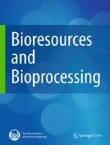Bioresources and Bioprocessing is associated with the State Key Laboratory of Bioreactor Engineering, East China University of Science and Technology.
Production of biodiesel by enzymatic transesterification of non-edible Salvadora persica (Pilu) oil and crude coconut oil in a solvent-free system
It is becoming imperative to develop renewable fuels such as biodiesel which are sustainable and environmentally friendly. Exploiting non-edible oils is more necessary to reduce dependency of edible oils for b...








































